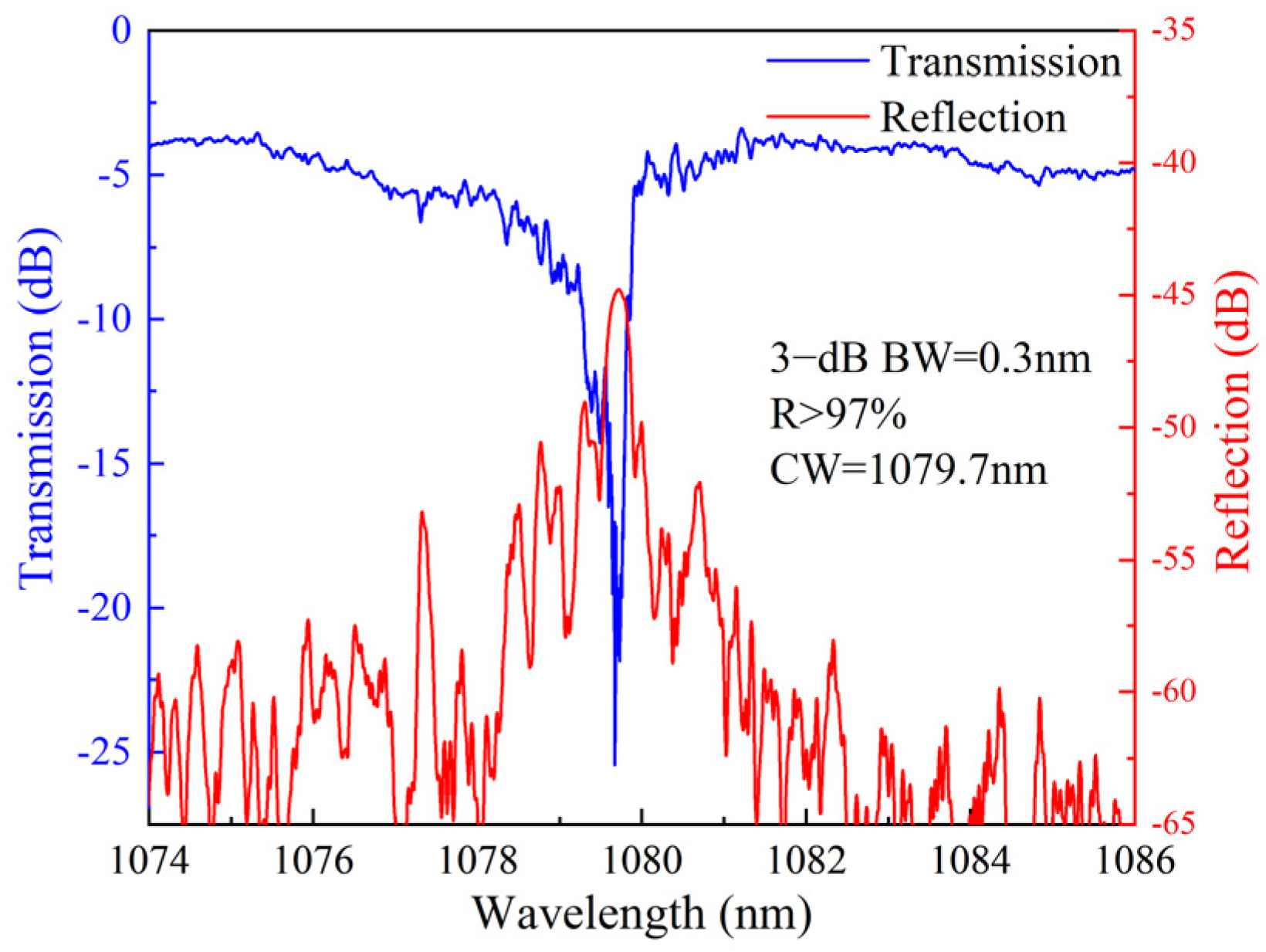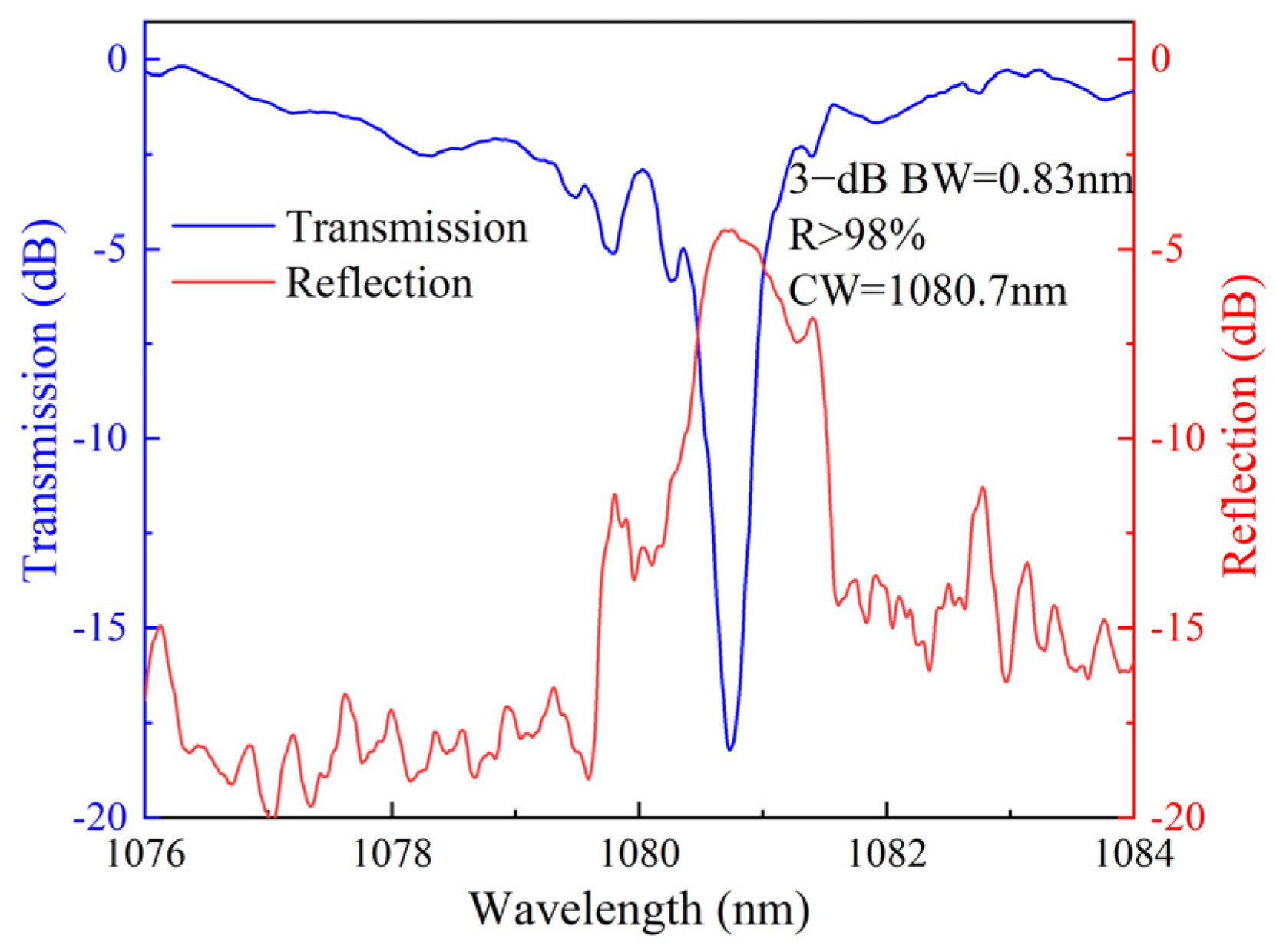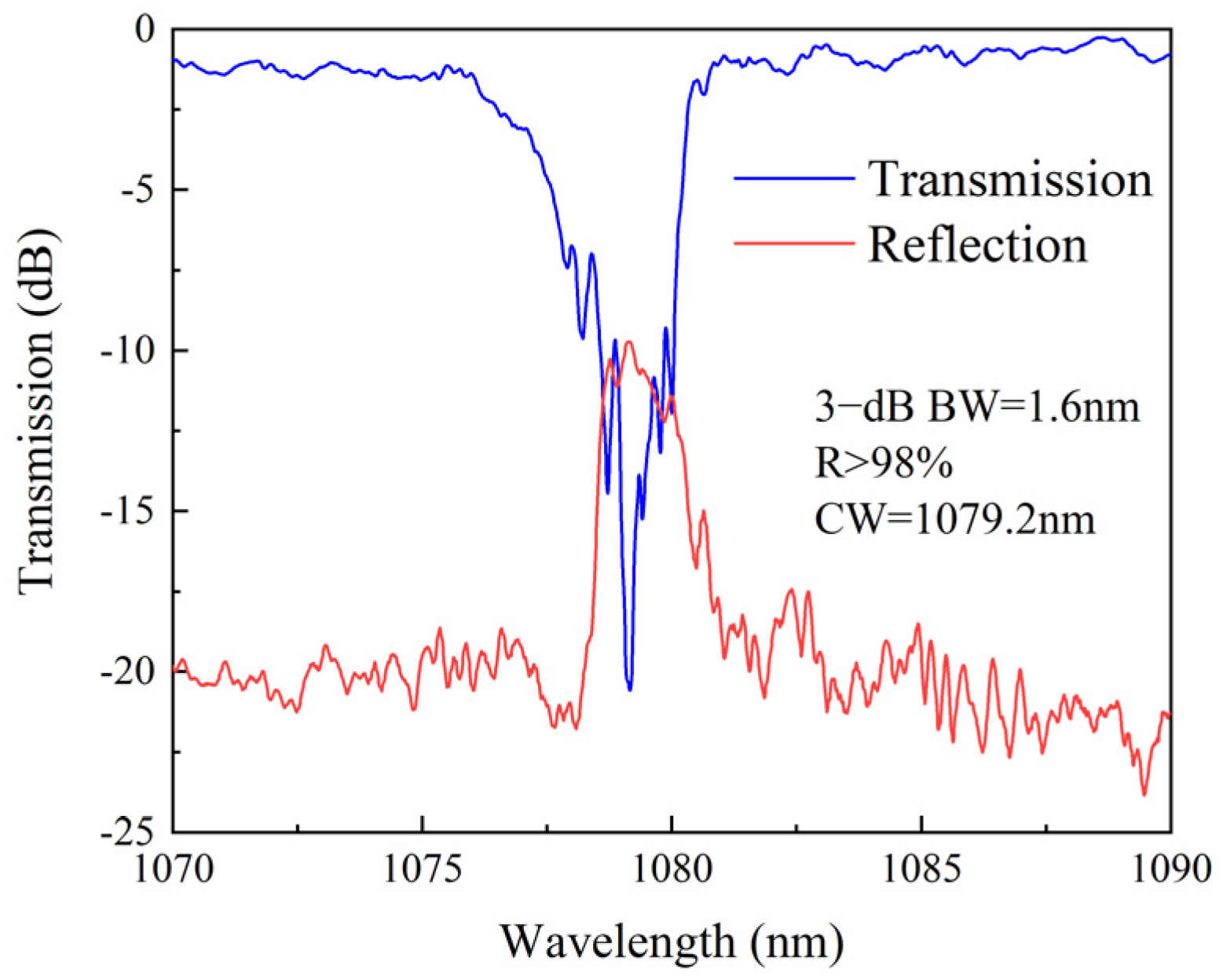Fabrication of Large-Core Multicore Fiber Bragg Gratings Based on Femtosecond Laser Direct Writing Technology
Abstract
1. Introduction
2. FBG Fabrication Based on the Grating Array Inscription Method
3. FBG Fabrication Based on the Plane-by-Plane Inscription Method
4. Conclusions
Author Contributions
Funding
Data Availability Statement
Conflicts of Interest
References
- Hill, K.O.; Fujii, Y.; Johnson, D.C.; Kawasaki, B.S. Photosensitivity in optical fiber waveguides: Application to reflection filter fabrication. Appl. Phys. Lett. 1978, 32, 647–649. [Google Scholar] [CrossRef]
- Jiajing, T.; Zhaohui, L. Review of space division multiplexing fibers. Acta Opt. Sin. 2021, 41, 106003. [Google Scholar] [CrossRef]
- Birks, T.A.; Mangan, B.J.; Díez, A.; Cruz, J.L.; Murphy, D.F. “Photonic lantern” spectral filters in multi-core fibre. Opt. Express 2012, 20, 13996–14008. [Google Scholar] [CrossRef] [PubMed]
- Pień, S.; Slowikowski; Tenderenda; Murawski; Szymanski; Szostkiewicz; Becker; Rothhardt; Bartelt; Mergo. Fiber Bragg gratings in hole-assisted multicore fiber for space division multiplexing. Opt. Lett. 2014, 39, 3571. [Google Scholar]
- Libo, Y.; Center, P. Multi-core fiber characteristics and its sensing applications. Laser Optoelectron. Prog. 2019, 20, 13996–14008. [Google Scholar]
- Dong, Y.; Nankuang, C.; Zhen, T.; Yicun, Y.; Liqiang, Z. Temperature sensor based on multicore fiber supermode interference. Laser Optoelectron. Prog. 2021, 58, 706007. [Google Scholar] [CrossRef]
- Gu, J.; Lu, B.; Yang, J.; Wang, Z.; Ye, L.; Ye, Q.; Qu, R.; Cai, H. Distributed acoustic sensing based on multi-core fiber. Acta Opt. Sin. 2021, 41, 706003. [Google Scholar]
- Fan, T.Y. Laser beam combining for high-power, high-radiance sources. IEEE J. Sel. Top. Quantum Electron. 2005, 11, 567–577. [Google Scholar] [CrossRef]
- Cheo, P.K.; Liu, A.; King, G.G. A high-brightness laser beam from a phase-locked multicore Yb-doped fiber laser array. IEEE Photonics Technol. Lett. 2002, 13, 439–441. [Google Scholar] [CrossRef]
- Flockhart, G.M.H.; Macpherson, W.N.; Barton, J.S.; Jones, J.D.C.; Zhang, L.; Bennion, I. Two-axis bend measurement with Bragg gratings in multicore optical fiber. Opt. Lett. 2003, 28, 387–389. [Google Scholar] [CrossRef]
- Lindley, E.; Min, S.S.; Leon-Saval, S.; Cvetojevic, N.; Lawrence, J.; Ellis, S.; Bland-Hawthorn, J. Demonstration of uniform multicore fiber Bragg gratings. Opt. Express 2014, 22, 31575–31581. [Google Scholar] [CrossRef] [PubMed]
- Liu, C.; Jiang, Y.; Li, J.; Du, B.; Liao, X.; Wang, J.; Yang, D. Selective fiber Bragg grating inscription in multicore fiber by femtosecond laser and phase mask. Opt. Lett. 2022, 47, 4000–4003. [Google Scholar] [CrossRef]
- Skvortsov, M.I.; Abdullina, S.R.; Wolf, A.A.; Dostovalov, A.V.; Vlasov, A.A.; Lobach, I.A.; Wabnitz, S.; Babin, S.A. Random Raman fiber laser based on a twin-core fiber with FBGs inscribed by femtosecond radiation. Opt. Lett. 2019, 44, 295–298. [Google Scholar] [CrossRef] [PubMed]
- Mihailov, S.J.; Hnatovsky, C.; Abdukerim, N.; Walker, R.B.; Lu, P.; Xu, Y.; Bao, X.; Ding, H.; De Silva, M.; Coulas, D. Ultrafast laser processing of optical fibers for sensing applications. Sensors 2021, 21, 1447. [Google Scholar] [CrossRef]
- Zlobina, E.A.; Kablukov, S.I.; Wolf, A.A.; Dostovalov, A.V.; Babin, S.A. Nearly single-mode Raman lasing at 954 nm in a graded-index fiber directly pumped by a multimode laser diode. Opt. Lett. 2016, 42, 9–12. [Google Scholar] [CrossRef]
- Thomas, J.; Voigtlaender, C.; Becker, R.G. Femtosecond pulse written fiber gratings: A new avenue to integrated fiber technology. Laser Photon. Rev. 2012, 6, 709–723. [Google Scholar] [CrossRef]
- Yang, K.; He, J.; Liao, C.; Wang, Y.; Liu, S.; Guo, K.; Zhou, J.; Li, Z.; Tan, Z.; Wang, Y. Femtosecond laser inscription of fiber Bragg grating in twin-core few-mode fiber for directional bend sensing. J. Lightwave Technol. 2017, 35, 4670–4676. [Google Scholar] [CrossRef]
- Donko, A.; Beresna, M.; Jung, Y.; Hayes, J.; Richardson, D.J.; Brambilla, G. Point-by-point femtosecond laser micro-processing of independent core-specific fiber Bragg gratings in a multi-core fiber. Opt. Express 2018, 26, 2039–2044. [Google Scholar] [CrossRef]
- Bronnikov, K.; Wolf, A.; Yakushin, S.; Dostovalov, A.; Egorova, O.; Zhuravlev, S.; Semjonov, S.; Wabnitz, S.; Babin, S. Durable shape sensor based on FBG array inscribed in polyimide-coated multicore optical fiber. Opt. Express 2019, 27, 38421–38434. [Google Scholar] [CrossRef]
- Lu, P.; Grobnic, D.; Mihailov, S.J. Characterization of the birefringence in fiber Bragg gratings fabricated with an ultrafast-infrared laser. J. Lightwave Technol. 2007, 25, 779–786. [Google Scholar] [CrossRef]
- Zhao, R.; Lu, X.; Gao, C.; Ye, X.; Li, H.; Wu, B.; Wang, M.; Wang, Z. Highly localized FBG fabricated by femtosecond laser single-pulse filaments. Opt. Laser Technol. 2025, 187, 112810. [Google Scholar] [CrossRef]
- Gao, C.; Zhao, R.; Wu, B.; Li, H.; Ye, X.; Wang, M.; Xu, X.; Wang, Z. Femtosecond laser direct writing large-area fiber Bragg grating based on diaphragm shaping. Opt. Express 2024, 32, 18582–18593. [Google Scholar] [CrossRef]








Disclaimer/Publisher’s Note: The statements, opinions and data contained in all publications are solely those of the individual author(s) and contributor(s) and not of MDPI and/or the editor(s). MDPI and/or the editor(s) disclaim responsibility for any injury to people or property resulting from any ideas, methods, instructions or products referred to in the content. |
© 2025 by the authors. Licensee MDPI, Basel, Switzerland. This article is an open access article distributed under the terms and conditions of the Creative Commons Attribution (CC BY) license (https://creativecommons.org/licenses/by/4.0/).
Share and Cite
Lu, X.; Zhao, R.; Gao, C.; Ye, X.; Qin, Q.; Li, H.; Li, Z.; Wang, M.; Chen, Z.; Wang, Z. Fabrication of Large-Core Multicore Fiber Bragg Gratings Based on Femtosecond Laser Direct Writing Technology. Nanomaterials 2025, 15, 891. https://doi.org/10.3390/nano15120891
Lu X, Zhao R, Gao C, Ye X, Qin Q, Li H, Li Z, Wang M, Chen Z, Wang Z. Fabrication of Large-Core Multicore Fiber Bragg Gratings Based on Femtosecond Laser Direct Writing Technology. Nanomaterials. 2025; 15(12):891. https://doi.org/10.3390/nano15120891
Chicago/Turabian StyleLu, Xinda, Rong Zhao, Chenhui Gao, Xinyu Ye, Qiushi Qin, Hao Li, Zhixian Li, Meng Wang, Zilun Chen, and Zefeng Wang. 2025. "Fabrication of Large-Core Multicore Fiber Bragg Gratings Based on Femtosecond Laser Direct Writing Technology" Nanomaterials 15, no. 12: 891. https://doi.org/10.3390/nano15120891
APA StyleLu, X., Zhao, R., Gao, C., Ye, X., Qin, Q., Li, H., Li, Z., Wang, M., Chen, Z., & Wang, Z. (2025). Fabrication of Large-Core Multicore Fiber Bragg Gratings Based on Femtosecond Laser Direct Writing Technology. Nanomaterials, 15(12), 891. https://doi.org/10.3390/nano15120891







